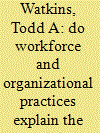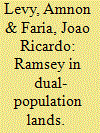| Srl | Item |
| 1 |
ID:
078233


|
|
|
|
|
| Publication |
2007.
|
| Summary/Abstract |
There is a large literature on the relationship between economic growth and defense spending, but its findings are often contradictory and inconclusive. These results may be partly due to non-linear growth effects of military expenditure and incorrect model specifications. The literature also appears lacking an empirical analysis of interaction between military spending and the arms trade and the impact of these two on growth. This paper investigates this non-linear interaction in the context of the Solow and Barro growth models recommended by Dunne et al.1 (2005). Using fixed effects, random effects, and Arellano-Bond GMM estimators, I examine the growth effects of military expenditure, arms trade, and their interaction in a balanced panel of 28 countries during 1965-2000. The augmented Solow growth model specified in Dunne et al. (2005) yields more robust estimates than the reformulated Barro model. I find that higher military spending and net arms exports separately lead to lower economic growth, but higher military spending is less detrimental to growth when a country is a net arms exporter.
|
|
|
|
|
|
|
|
|
|
|
|
|
|
|
|
| 2 |
ID:
078235


|
|
|
|
|
| Publication |
2007.
|
| Summary/Abstract |
This paper explores whether defense contractors' manufacturing technology advantages over purely commercial firms might be associated with differences in their workforce and organizational practices. It uses unique original data collected specifically to test workforce and organizational complementarities in implementation of advanced manufacturing technology in small manufacturers. Findings are that defense contractors: (1) have higher and deeper rates of advanced manufacturing technology use; (2) have greater perceived success in achieving manufacturing goals; (3) are more likely practitioners across a diverse spectrum of advanced workforce and organizational practices. Then, (4) econometrically, the defense contractors' higher reported levels of achievement in implementing advanced manufacturing technologies are positively associated with those organizational and workforce practice differences
|
|
|
|
|
|
|
|
|
|
|
|
|
|
|
|
| 3 |
ID:
078232


|
|
|
|
|
| Publication |
2007.
|
| Summary/Abstract |
The enlargement of the EU has implications for the national defence requirements and therefore national defence policy of European nations. In light of the freedom of movement of citizens between member states it is appropriate to consider the implications of a country's military expenditure for its macroeconomy and specifically on the flows of migration between member states. Traditionally, income differentials, employment levels and relative standards of living are all factors that influence an individual's decision to migrate. To this list we add the level of military expenditure. Migration from a panel of 16 Central and Eastern European Countries (CEECs) to Germany between 1995 and 2002 is found to be the result of the level of military expenditure of the source country and the host country in conjunction with factors consistent with standard theoretical predictions
|
|
|
|
|
|
|
|
|
|
|
|
|
|
|
|
| 4 |
ID:
078237


|
|
|
|
|
| Publication |
2007.
|
| Summary/Abstract |
The goal of this paper is to examine the nexus between GDP and military expenditure. We model this relationship within a multivariate framework by including exports in the model. We use the recently developed bounds testing approach to cointegration and find that there is a long run relationship among the variables when GDP is the endogenous variable. Normalizing on GDP and using four different estimators, we find that in the long run both military expenditure and exports have a positive impact on GDP. Finally, using the Granger causality test, we find that there is evidence for military expenditure Granger causing exports and exports Granger causing GDP, implying that military expenditure indirectly Granger causes GDP in the short run. In the long run, we find that both military expenditure and exports Granger cause GDP for Fiji. Our findings are consistent with the Keynesian school of thought, leading us to derive some policy implications.
|
|
|
|
|
|
|
|
|
|
|
|
|
|
|
|
| 5 |
ID:
078234


|
|
|
|
|
| Publication |
2007.
|
| Summary/Abstract |
Ramsey's model is extended to three possible scenarios of conflicts in dual-population lands: partition, federation and civil war. The federally utility-maximizing consumption-growth rate in a strictly political federation might be lower than that under partition for the wealthier and more slowly multiplying group. This group may benefit from joining a federation that facilitates technological transfer and from obeying the federal no-arbitrage rule as long as its own technology is inferior to the hybrid. The utility-maximizing consumption growth rate for a group engaged in a civil war is larger than those under partition and a strictly political federation if its rival's warfare is mainly aimed at inflicting casualties and is likely to be smaller when its rival's warfare is mainly sabotage
|
|
|
|
|
|
|
|
|
|
|
|
|
|
|
|
| 6 |
ID:
078236


|
|
|
|
|
| Publication |
2007.
|
| Summary/Abstract |
The new strategic environment that was created with the end of the Cold War, led many European countries to abolish conscription and adopt an all volunteer force (AVF). Even though it is not likely for the Turkish Armed Forces to adopt an AVF in the near future, the issue has been in the official documents of the Turkish Armed Forces since the 1990s. Thus, efforts have been made by all services to increase the ratio of professional officers. One possible way of achieving this is the re-enlistment of present recruits. This paper examines the possible economic and socio-economic determinants of the re-enlistment decision of recruits for Turkey's Armed Forces. The empirical findings indicate that the geographical background as well as economic welfare is influential in the re-enlistment decision.
|
|
|
|
|
|
|
|
|
|
|
|
|
|
|
|